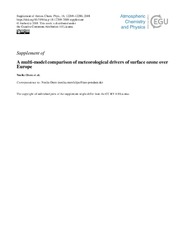| dc.contributor.author | Otero, Noelia | |
| dc.contributor.author | Sillmann, Jana | |
| dc.contributor.author | Mar, Kathleen | |
| dc.contributor.author | Rust, Henning W. | |
| dc.contributor.author | Solberg, Sverre | |
| dc.contributor.author | Andersson, Camilla | |
| dc.contributor.author | Engardt, Magnuz | |
| dc.contributor.author | Bergström, Robert | |
| dc.contributor.author | Bessagnet, Bertrand | |
| dc.contributor.author | Colette, Augustin | |
| dc.contributor.author | Couvidat, Florian | |
| dc.contributor.author | Cuvelier, Cornelius | |
| dc.contributor.author | Tsyro, Svetlana | |
| dc.contributor.author | Fagerli, Hilde | |
| dc.contributor.author | Schaap, Martijn | |
| dc.contributor.author | Manders, Astrid | |
| dc.contributor.author | Mircea, Mihaela | |
| dc.contributor.author | Briganti, Gino | |
| dc.contributor.author | Cappelletti, Andrea | |
| dc.contributor.author | Adani, Mario | |
| dc.contributor.author | D'Isidoro, Massimo | |
| dc.contributor.author | Pay, María Teresa | |
| dc.contributor.author | Theobald, Mark | |
| dc.contributor.author | Vivanco, Marta G. | |
| dc.contributor.author | Wind, Peter | |
| dc.contributor.author | Ojha, Narendra | |
| dc.contributor.author | Raffort, Valentin | |
| dc.contributor.author | Butler, Tim | |
| dc.date.accessioned | 2018-09-04T11:29:54Z | |
| dc.date.available | 2018-09-04T11:29:54Z | |
| dc.date.issued | 2018-08-24 | |
| dc.description.abstract | The implementation of European emission abatement strategies has led to a significant reduction in the emissions of ozone precursors during the last decade. Ground-level ozone is also influenced by meteorological factors such as temperature, which exhibit interannual variability and are expected to change in the future. The impacts of climate change on air quality are usually investigated through air-quality models that simulate interactions between emissions, meteorology and chemistry. Within a multi-model assessment, this study aims to better understand how air-quality models represent the relationship between meteorological variables and surface ozone concentrations over Europe. A multiple linear regression (MLR) approach is applied to observed and modelled time series across 10 European regions in springtime and summertime for the period of 2000–2010 for both models and observations. Overall, the air-quality models are in better agreement with observations in summertime than in springtime and particularly in certain regions, such as France, central Europe or eastern Europe, where local meteorological variables show a strong influence on surface ozone concentrations. Larger discrepancies are found for the southern regions, such as the Balkans, the Iberian Peninsula and the Mediterranean basin, especially in springtime. We show that the air-quality models do not properly reproduce the sensitivity of surface ozone to some of the main meteorological drivers, such as maximum temperature, relative humidity and surface solar radiation. Specifically, all air-quality models show more limitations in capturing the strength of the ozone–relative-humidity relationship detected in the observed time series in most of the regions, for both seasons. Here, we speculate that dry-deposition schemes in the air-quality models might play an essential role in capturing this relationship. We further quantify the relationship between ozone and maximum temperature (mo3 − T, climate penalty) in observations and air-quality models. In summertime, most of the air-quality models are able to reproduce the observed climate penalty reasonably well in certain regions such as France, central Europe and northern Italy. However, larger discrepancies are found in springtime, where air-quality models tend to overestimate the magnitude of the observed climate penalty. | en_US |
| dc.description.sponsorship | Federal Ministry of Education and Research of Germany
The Ministry for Science, Research and Culture of the State of Brandenburg
The Swedish Environmental Protection Agency
NordForsk
NILU - Norsk institutt for luftforskning | en_US |
| dc.description | Source at <a href=https://doi.org/10.5194/acp-18-12269-2018> https://doi.org/10.5194/acp-18-12269-2018</a>. | en_US |
| dc.identifier.citation | Otero, N., Sillmann, J., Mar, K.A., Rust, H.W., Solberg, S., Andersson, C., ... Butler, T. (2018). A multi-model comparison of meteorological drivers of surface ozone over Europe. Atmospheric Chemistry and Physics, 18(16), 12269-12288. https://doi.org/10.5194/acp-18-12269-2018 | en_US |
| dc.identifier.cristinID | FRIDAID 1605471 | |
| dc.identifier.doi | 10.5194/acp-18-12269-2018 | |
| dc.identifier.issn | 1680-7316 | |
| dc.identifier.issn | 1680-7324 | |
| dc.identifier.uri | https://hdl.handle.net/10037/13646 | |
| dc.language.iso | eng | en_US |
| dc.publisher | European Geosciences Union | en_US |
| dc.relation.journal | Atmospheric Chemistry and Physics | |
| dc.relation.projectID | info:eu-repo/grantAgreement/RCN/KLIMAFORSK/244551/Norway/Interaction of Climate Extremes, Air Pollution and Agro-ecosystems// | en_US |
| dc.rights.accessRights | openAccess | en_US |
| dc.subject | VDP::Matematikk og Naturvitenskap: 400::Geofag: 450::Meteorologi: 453 | en_US |
| dc.subject | VDP::Mathematics and natural science: 400::Geosciences: 450::Meteorology: 453 | en_US |
| dc.title | A multi-model comparison of meteorological drivers of surface ozone over Europe | en_US |
| dc.type | Journal article | en_US |
| dc.type | Tidsskriftartikkel | en_US |
| dc.type | Peer reviewed | en_US |


 English
English norsk
norsk
